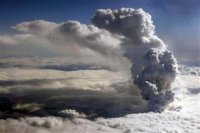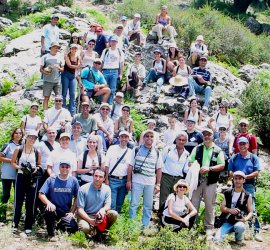
Iceland volcano: not yet a global cooling eruption
OSLO (Reuters) - A vast cloud from an intensifying volcanic eruption in Iceland is too small so far to slow global warming as happened in 1991 with the explosion of Mount Pinatubo in the Philippines, experts say.
Cataclysmic eruptions, led by Pinatubo and Mount Chichon in Mexico in 1982 in the 20th century, spewed so much debris into the upper atmosphere that they cooled the planet for months, briefly offsetting the effect of industrial heat-trapping gases.
"This is not like Pinatubo. So far the scale is not big enough to have a global effect," said Hans Olav Hygen, a climate researcher at the Norwegian Meteorological Institute.
The eruption under the Eyjafjallajokull glacier -- 10 times more powerful than another nearby last month -- threw up a 6 km (3.7 mile) cloud of ash and closed down air traffic across northern Europe.
"At the moment this is a relatively small eruption, not as big as some in the past from Iceland," said Colin Macpherson, a geologist at the University of Durham in England. Experts were monitoring to see possible impacts of ash on health.
A poison cloud from the eruption of Iceland's Laki volcano in 1783-84 killed thousands of people across Europe and undermined farm output by spewing an estimated 120 million metric tons of sulfur dioxide into the air, he said.
That amount of sulfur dioxide was three times European industrial output in 2006, he said.
STRATOSPHERE
Volcanic sulfur gases ejected high into the stratosphere and swept around the globe in the jetstream can linger for 12-14 months and dim sunlight, according to the U.N. panel of climate scientists.
Heavier ash generally falls back to Earth -- where it can cause respiratory problems -- within 3 months.
Some experts advocate the deliberate injection of sulfur dioxide in the stratosphere in a "geo-engineering" short cut to slow global warming and offset more floods, heatwaves, droughts, and rising sea levels.
That option has become attractive for some after a U.N. climate summit in Copenhagen in December failed to produce a binding global deal to cut emissions of greenhouse gases. Others say the risks are too big -- ranging from disruptions of weather patterns to acid rain.
"Pinatubo was the last major event. The levels of aerosols in the upper atmosphere have been fairly low of late," said Geoff Dollard, practice leader on air quality at the AEA consultancy which advises the British government
"Generally there's a cooling effect from aerosols," he said. This is a lightish dust. We are keeping an eye on it" for possible threats to health. Dust in the air is nothing new -- storms from the Sahara can bring an orange-ish dust to northern Europe.
On an index of climate change since 1980 run by the International Geosphere-Biosphere Program, conditions got worse every year except 1982, 1992 and 1996. It links the dips to volcanic fallout from Chichon, Pinatubo and Monserrat in 1996







 Karim Maalouf
Karim Maalouf
